Big, strong, rounded shoulders have numerous benefits besides just looking good. The deltoids are among the most important muscles in the body, as we use them in everyday life to push, pull, and lift objects over our heads.
You may be surprised to know that your anterior deltoids are the biggest of the three deltoid heads.
Your front delts are activated during all compound pressing exercises, such as push-ups, bench presses, and overhead presses.
But sometimes, we must focus more on the front delt to build a bigger, round shoulder. Building strong anterior deltoids helps improve posture and make arm movements that involve shoulder abduction more powerful and productive.
In this post, we will discuss the following give you techniques on How to grow your front delts, best exercises, execution techniques, pro tips

7 Best Exercises To Build Bigger Front Delts
While numerous exercises target the anterior deltoid exist, there are two types of exercises: presses and raises.
- Presses, like incline bench presses and overhead presses, are the ultimate anterior deltoid strength exercises. It is a compound exercise that targets many other muscle fibers.
- Raises, such as shoulder front raises and many other variations, are isolation exercises that mainly target the front deltoid. Front delts respond well to light weights with high volume, particularly regarding hypertrophy.
And There are MANY ways to train the front deltoid using different gym types of equipment:
- Barbell Front Delt Workouts.
- Anterior Delt Exercises with Dumbbells.
- Cable Anterior Deltoid Exercises
- Bodyweight Delt exercises (No Equipments).
Try Our FREE Workout Planner to generate your customized workout plans..
1. Barbell Overhead Press
The shoulder press is the best exercise for building muscle mass and strength. It remains the granddaddy of all shoulder exercises to build big, round shoulder muscles.
The seated shoulder press is the favorite shoulder exercise among bodybuilders because it builds muscle fast and is a power move.
Performing the exercise while seated upright is a stricter version than standing and prevents cheating the weight upward using momentum generated by the legs.
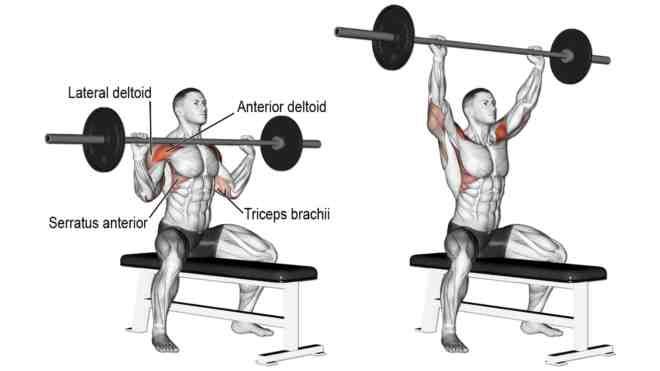
How To Do
- Sit on an exercise bench and grab a bar with an overhand grip.
- Bring the bar over and in front of your head, under your chin, and just above your upper chest.
- Now Press the bar straight up overhead until your arms are fully extended but not locked out.
- Slowly lower the bar back to the starting position.
Tips
- Perform a warm-up with 50% weight for 1–2 sets.
- Always perform the Shoulder Exercises before you perform the triceps.
2. Barbell front raise
The barbell front raise is an effective exercise for targeting the anterior deltoids as you can perform it in various grip widths and hand positions.
The barbell allows you to overload the muscles more than you could with dumbbells.
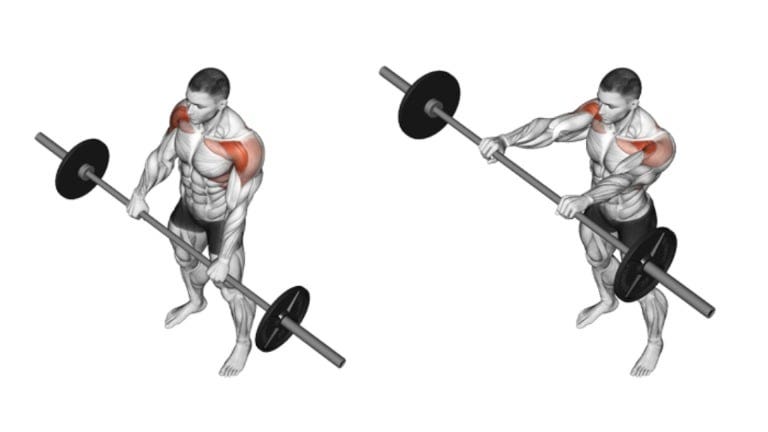
How To Do
- Stand with your feet shoulder-width apart and grasp a barbell with an overhand grip.
- Hold the barbell in front of your thighs, palms facing down, and your hands slightly wider than shoulder-width apart.
- Keep your back straight, engage your core, and slightly bend your elbows.
- Lift the barbell up slowly in front of you. Make sure your arms are parallel to the ground or slightly higher.
- Pause briefly at the top of the movement, then lower the barbell back down to the starting position.
Tips
- Maintain a neutral back and engage your core.
- Keep a controlled motion and avoid jerky movements.
3. The Landmine Overhead Press
The Landmine overhead press is a compound exercise that targets the shoulders, triceps, and chest muscles.
It is not a popular exercise, yet it provides many benefits for progressing your anterior deltoid and upper chest.
As it is performed in a standing position, it increases core involvement and can improve core stability and abdominal muscle strength.
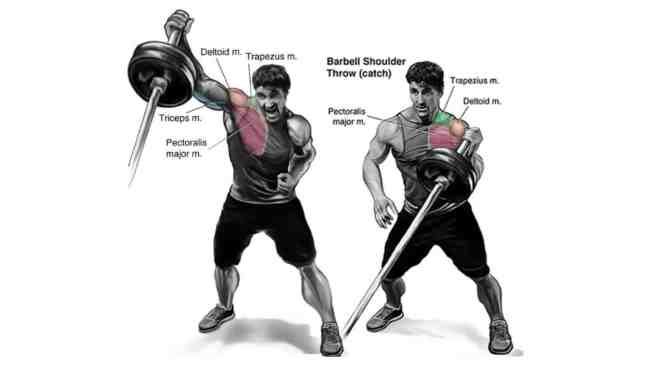
How To Do
- Stand holding the weighted end of the barbell with both hands in front of your chest.
- Make sure the barbell is wedged securely in a landmine device or corner.
- Your feet should be level and shoulder-width apart.
- Press the barbell overhead by extending your arms, exhaling as you push the weight up.
- Pause briefly at the top of the movement with your arms fully extended.
- Lower the barbell back down to the starting position in a controlled manner while inhaling.
Tips
- Hold a neutral spine throughout the movement to prevent injury.
- Ensure that the barbell is stable.
- Brace your core, keep your back straight, and maintain a slight bend in your knees.
Try Our FREE Workout Planner to generate your customized workout plans..
4. Arnold Shoulder Press
The Arnold shoulder press is a popular exercise named after the legendary bodybuilder Arnold Schwarzenegger.
It stands out from the crowd as the best exercise with the best range of motion for shoulder muscles.
It provides a wide range of motion as you lower the dumbbells well down in front, achieving the maximum stretch other shoulder exercises lack.
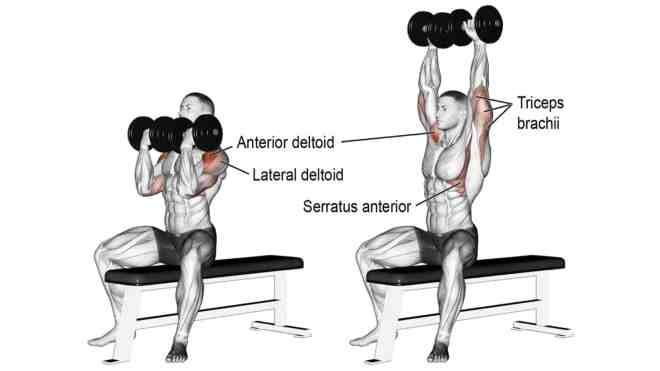
How To Do
- Sit on a bench or standing tall with feet shoulder-width apart.
- Hold the dumbbells at shoulder level with your palms facing your body.
- Begin the movement by pressing the dumbbells overhead while simultaneously rotating your palms away from your body.
- As you press upward, rotate your palms until they face forward.
- Pause at the top and then reverse the movement by rotating your palms back towards your body as you lower the dumbbells back down to the starting position.
Tips
- Keep a controlled motion and avoid jerky movements.
- Do not lock your arms overhead.
5. Dumbbell Front Raise
The dumbbell front raise is one of the best isolation exercises for isolating the front deltoid muscle.
This exercise can be done with a pair of dumbbells standing or sitting. The seated version requires strict form and prevents cheating.
It is also possible to perform them alternatingly or with both hands together.
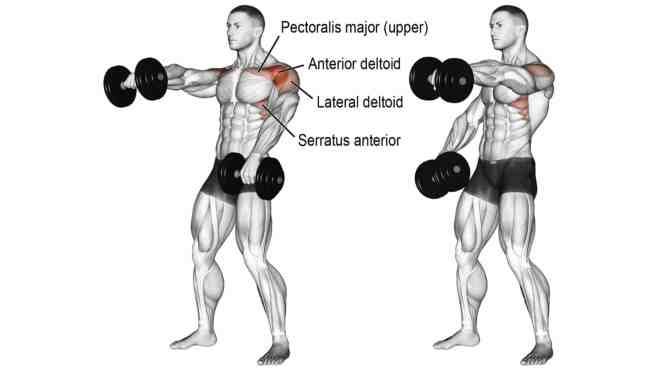
How To Do
- Stand holding a pair of dumbbells across the front of your thighs.
- Your feet are shoulder-width apart, and your knees are slightly bent.
- Raise one dumbbell (say right hand) in front of you until it reaches just above shoulder level.
- Now lower the weight (of the right hand) while raising the left in front of you.
- Perform this exercise in this alternating manner.
Tips
- Pause momentarily at the top, then slowly lower the dumbbell back to the starting position.
- Concentrate on training the front delts. Lift dumbbells before you; do not raise them outside the body.
6. Cable front raise
The cable front raise is useful because it provides constant tension on the front delt as you move the weight through the range of motion.
You can also perform the cable front raise using a rope attachment or a single stirrup, one arm at a time.

How To Do
- Attach a straight bar to a low cable pulley.
- Grab the bar using a shoulder-width or wider overhand grip.
- Stand close to the pulley with your body upright, your shoulders pulled back.
- Exhale as you pull the bar up the front of your body until the bar is at shoulder height.
- Hold for a count of two. Inhale as you lower the bar to the starting position.
Tips
- Keep your shoulders back, chest out, and body upright.
- Pause for a moment at the top position.
- Try not to bounce at the top of the movement, allow the shoulders to flex and then lower slowly.
7. Barbell Push Press
The barbell push press is a works multiple muscle groups, including shoulders, triceps, core, and legs.
It allows you to lift heavier weights overhead compared to a strict military press.

How To Do
- Place your feet hip-width apart and grasp a barbell at shoulder height with an overhand grip.
- Bend your knees and dip your hip back.
- Bend your knees slightly as if performing a shallow squat. This is the “dip” phase.
- Now, explosively extend your legs to drive upwards, generating momentum.
- As your legs extend, simultaneously press the barbell directly overhead until your arms are straight
- Slowly lower the barbell back to the starting position at your shoulders.
BONUS: Pike Push Up
Pike Push-ups aka shoulder push-up is a variation of the push-up that increases strength and stability in the shoulders and triceps.
The pike push-up looks like a mash-up of Downward-Facing Dog and Dolphin Pose, and this move can build major strength.
Perform this exercise more upright to target the shoulders more than the chest.
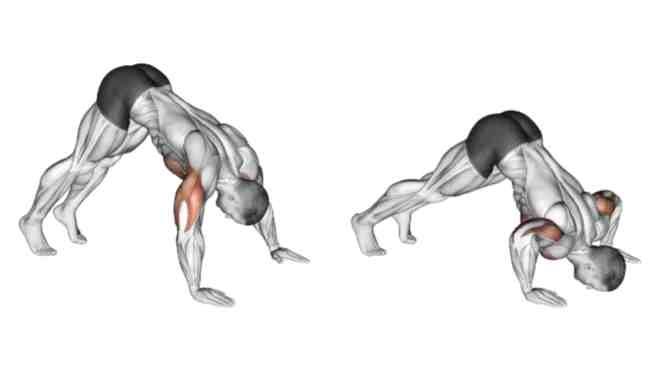
How To Do
- Start in a standard push-up position with your hands slightly wider than shoulder-width apart and elbows completely locked out.
- Lift the hips up and back until your body forms an inverted V shape.
- Keep arms and legs as straight as possible.
- Slowly lower the top of your head towards the ground.
- Once your head is about to contact the ground, pause for a second.
- Then slowly push back until your arms are straight, and you’re in the inverted V position.
Tips
- Make sure you maintain control throughout the movement.
Optimal Sets and Reps
Here’s a breakdown of optimal sets and reps for different training styles:
Strength Training
- Sets: 3
- Reps: 6–10
Hypertrophy
- Sets: 3
- Reps: 8–15
Endurance Training
- Sets: 3
- Reps: 12–30
Power Training
- Sets: 3
- Reps: 5–8 (Explosive)
Conclusion
These anterior deltoid exercises are recommended for anyone who wants to build a bigger shoulder and gain strength.
It allows for targeted muscle development and provides an overall 3D look to the shoulder. It is easy to do and requires no more scientific details or fancy equipment. You should incorporate some of these 7 exercises into your workout regimen.
To sum it up, you should hit your front delts directly at least 1 time a week, but if you’re lacking in this area, you might want to work them more often than that.
References
- Adel Elzanie and Varacallo, M. (2023). Anatomy, Shoulder and Upper Limb, Deltoid Muscle.
- Smita Maruvada, Madrazo-Ibarra, A. and Varacallo, M. (2023). Anatomy, Rotator Cuff.
- Campos YAC, Vianna JM, Guimarães MP, Oliveira JLD, Hernández-Mosqueira C, da Silva SF, Marchetti PH. Different Shoulder Exercises Affect the Activation of Deltoid Portions in Resistance-Trained Individuals. J Hum Kinet. 2020 Oct 31;75:5–14.